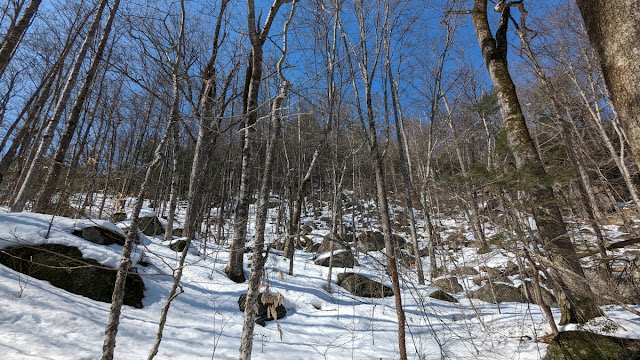I've known for years about a stand of old growth sugar maples in the Hamlin Town forest in Meredith. The maple grove is noted on the trail map of the property and I'm always amazed at their size and age. During a snowshoe trip on that trail this week my eye was caught by another very large tree, which on inspection, is a huge old American beech.
 |
| American Beech |
I didn't have anything to measure its circumference, but I estimated it to be about 65 inches.
Beech has smooth gray bark in its early years but as it ages is becomes rough and cracked, so I know this is an old tree, but I'm not able to guess at its age, though the sugar maples here have been estimated at over 250 years old.
Now my eye seemed to be tuned to looking up, and soon I noticed another large tree.
 |
| Yellow Birch |
This I identified as a yellow birch based on its distinctive soft and peeling bark. Unlike white (or paper) birch, yellow birch is a very long living tree. Could this also be a couple of hundred years old? Yellow birch is supposed to have a sweet, minty aroma in its leaves and twigs; it would be long climb to scrape a twig to smell it on this specimen.
Next to be found was a red pine:
 |
| Red Pine |
Red pine, though not rare, have a specific habitat they prefer, dry and sandy, so I was a little surprised to see it here. But based on the bark I'm pretty sure it's a red pine.
 |
| Red pine has a smooth, scaly, reddish bark. |
The crown and needles are also rather distinctive, though the needles were too far away to examine.
All four of these trees were in close proximity to each other. A short distance away I came upon yet another majestic tree, a towering white ash.
 |
| White Ash |
Ash is another tree with a distinctive bark pattern which makes it identifiable in winter.
 |
| Diamond shaped furrows on white ash. |
This is one of the largest ash trees I've seen and it may be largest I'll ever see as the emerald ash borer works its way through New Hampshire, destroying all the large ash trees. Perhaps this one, hidden among all these other tall timbers won't be found by the invasive insect - wishful thinking, I know.
I didn't pass by the grandfather of all the trees in this forest on this excursion: the ancient black tupelo (or black gum) tree that has been documented at 450 years old. I understand why this tree and the sugar maples were not cut down years ago: the wood of the black tupelo is so hard that no one wants to work with it, and the sugar maples were more valuable as a maple syrup cash-crop than as saw logs. Why the other large trees are still standing is more of a mystery. Clearly the area has been logged in the past based on the lack of mature white pine and hemlock. Perhaps the wood of these trees just wasn't in demand when it was logged in the past.
Another question: why hadn't I noticed these trees in my many prior hikes on this trail? I'm sure the good visibility due to the lack of leaves on the trees was a factor, but I think the bright sun, blue sky, and white snow also made these handsome trees stand out on that pretty March day.
We may be well into March but there is still 17 inches of ice on the lake, and even taking out the four inches of porous frozen slush on top, that's over a foot of ice the March sun still has to bore through. With a bit more snow yesterday, we've got a long ways to go before ice out.
 |
| Open water slowly works its way back from the outlet of Lake Wicwas. |



Thanks Scott. Great day for a hike.
ReplyDeleteIt certainly was!
ReplyDeleteGreat job Scott!!!
ReplyDelete